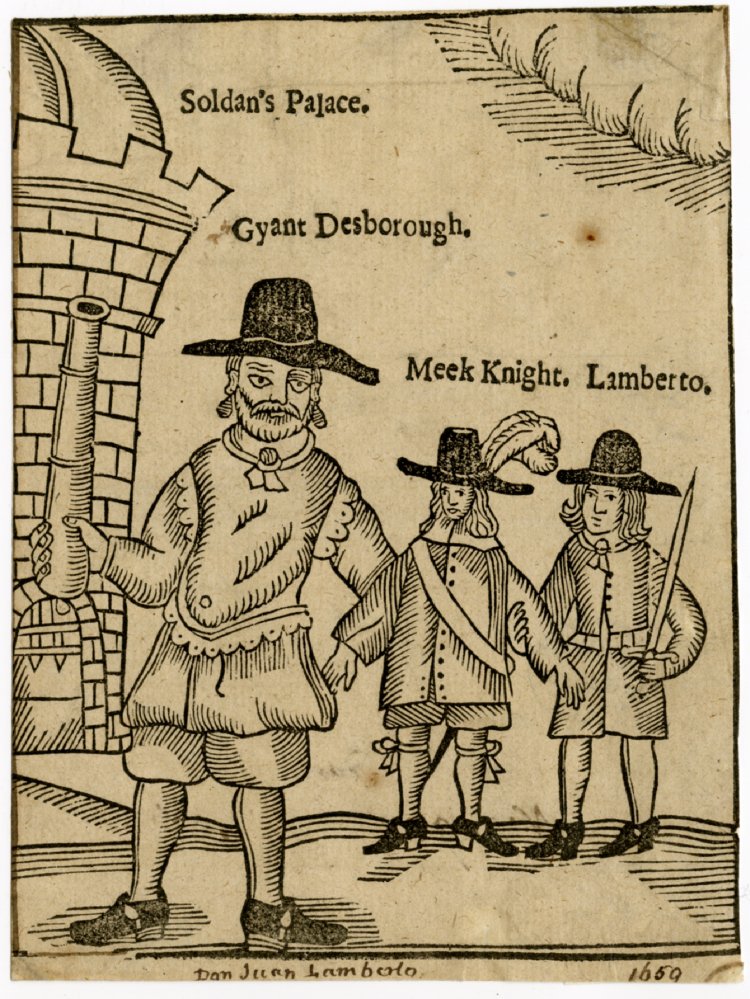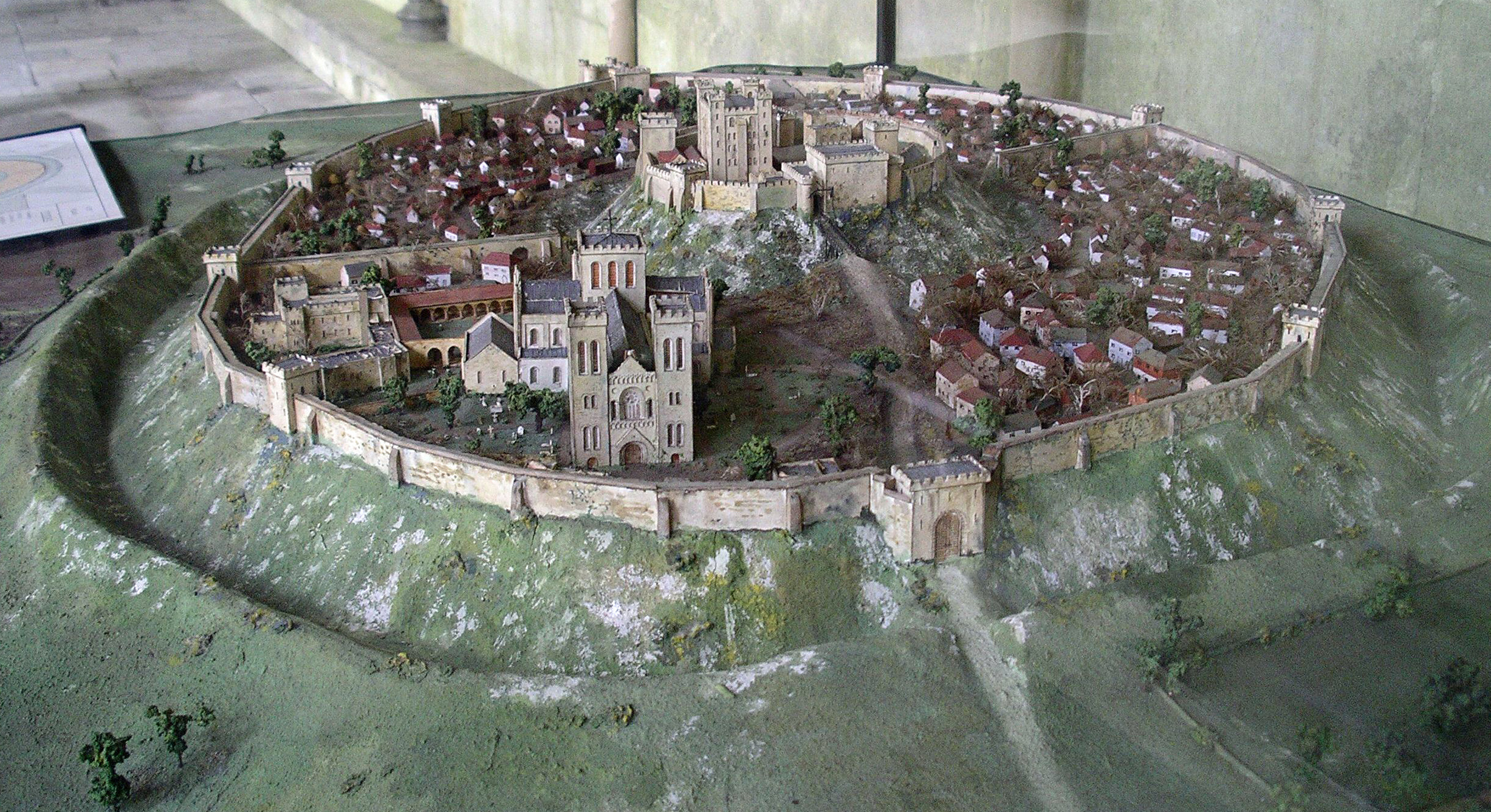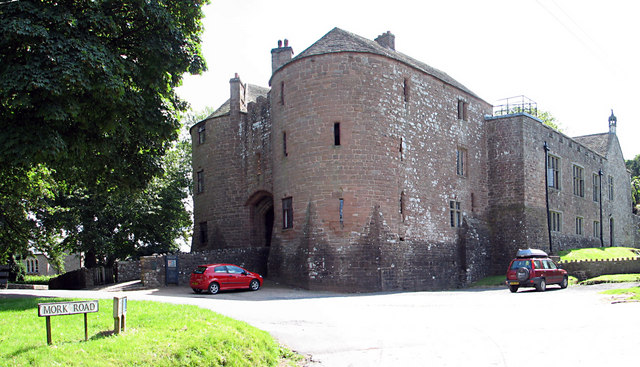|
Major General John Desboroe
John DesboroughAlso spelt John Disbrowe and John Desborow (the latter in the Indemnity and Oblivion Act, section XLIII) (1608–1680) was an English soldier and politician who supported the parliamentary cause during the English Civil War. Life He was the son of James Desborough of Eltisley, Cambridgeshire, and of Elizabeth Hatley of Over in the same county. He was baptized on 13 November 1608. He was educated in law. On 23 June 1636 he married Jane, daughter of Robert Cromwell of Huntingdon and sister of Oliver Cromwell – the future Lord Protector, at Eltisley. He took an active part in the English Civil War, and showed considerable military ability. In 1645, he was present as major in the engagement at Langport on 10 July, at Hambleton Hill on 4 August, and on 10 September he commanded the horse at the Storming of Bristol. Later he took part in the operations round Oxford. In 1648, as colonel he commanded the forces at Great Yarmouth. He avoided all participation in th ... [...More Info...] [...Related Items...] OR: [Wikipedia] [Google] [Baidu] |
English Civil War
The English Civil War or Great Rebellion was a series of civil wars and political machinations between Cavaliers, Royalists and Roundhead, Parliamentarians in the Kingdom of England from 1642 to 1651. Part of the wider 1639 to 1653 Wars of the Three Kingdoms, the struggle consisted of the First English Civil War and the Second English Civil War. The Anglo-Scottish war (1650–1652), Anglo-Scottish War of 1650 to 1652 is sometimes referred to as the ''Third English Civil War.'' While the conflicts in the three kingdoms of England, Kingdom of Scotland, Scotland and Kingdom of Ireland, Ireland had similarities, each had their own specific issues and objectives. The First English Civil War was fought primarily over the correct balance of power between Parliament of England, Parliament and Charles I of England, Charles I. It ended in June 1646 with Royalist defeat and the king in custody. However, victory exposed Parliamentarian divisions over the nature of the political settlemen ... [...More Info...] [...Related Items...] OR: [Wikipedia] [Google] [Baidu] |
Salisbury
Salisbury ( , ) is a city status in the United Kingdom, cathedral city and civil parish in Wiltshire, England with a population of 41,820, at the confluence of the rivers River Avon, Hampshire, Avon, River Nadder, Nadder and River Bourne, Wiltshire, Bourne. The city is approximately from Southampton and from Bath, Somerset, Bath. Salisbury is in the southeast of Wiltshire, near the edge of Salisbury Plain. An ancient cathedral was north of the present city at Old Sarum Cathedral, Old Sarum. A Salisbury Cathedral, new cathedral was built near the meeting of the rivers and a settlement grew up around it, which received a city charter in 1227 as . This continued to be its official name until 2009 structural changes to local government in England, 2009, when Salisbury City Council was established. Salisbury railway station is an interchange between the West of England line, West of England Line and the Wessex Main Line. Stonehenge, a UNESCO World Heritage Site, is northwest o ... [...More Info...] [...Related Items...] OR: [Wikipedia] [Google] [Baidu] |
Richard Cromwell
Richard Cromwell (4 October 162612 July 1712) was an English statesman who served as Lord Protector of the Commonwealth of England, Scotland and Ireland from 1658 to 1659. He was the son of Lord Protector Oliver Cromwell. Following his father's death in 1658, Richard became Lord Protector, but he lacked authority. He tried to mediate between the army and civil society, and allowed a Parliament that contained many disaffected Presbyterians and Cavalier, Royalists to sit. Suspicions that civilian councillors were intent on supplanting the army peaked in an attempt to prosecute a major-general for actions against a Royalist. The army made a threatening demonstration of force against Richard, and may have had him in detention. He formally renounced power only nine months after succeeding. Though a Royalist revolt was crushed by the recalled civil war figure General John Lambert (general), John Lambert, who subsequently prevented the Rump Parliament from reconvening and created a C ... [...More Info...] [...Related Items...] OR: [Wikipedia] [Google] [Baidu] |
Cromwell's Upper House
The Other House (also referred to as the Upper House, House of Peers and House of Lords), established by the Lord Protector Oliver Cromwell under the terms of the Humble Petition and Advice, was one of the two chambers of the parliaments that legislated for England and Wales, Scotland, and Ireland, in 1658 and 1659, the final years of the Protectorate.The Humble Partition states "to create the 'Other House,' the members to be such as should be nominated by his highness and approved by the commons". George Craik notes "The commonwealth-men, it appears, would tolerate neither the designation 'House of Lords.' nor that of 'Upper House.' The thing was, therefore, termed 'the Other House;' that branch of the legislature losing not less in real power than it lost in name or dignity: they were not to exceed seventy in number, nor to be less than forty, whereof one-and-twenty were to form a quorum; they were not to give any vote by proxy; on death or removal no new members were to be admit ... [...More Info...] [...Related Items...] OR: [Wikipedia] [Google] [Baidu] |
Protector's Privy Council
The English Council of State, later also known as the Protector's Privy Council, was first appointed by the Rump Parliament on 14 February 1649 after the execution of King Charles I. Charles's execution on 30 January was delayed for several hours so that the House of Commons could pass an emergency bill to declare the representatives of the people, the House of Commons, as the source of all just power and to make it an offence to proclaim a new King. This in effect abolished the monarchy and the House of Lords. History The Council of State was appointed by Parliament on 14 and 15 February 1649, with further annual elections. The Council's duties were to act as the executive of the country's government in place of the King and the Privy Council. It was to direct domestic and foreign policy and to ensure the security of the English Commonwealth. Due to the disagreements between the New Model Army and the weakened Parliament, it was dominated by the Army. The Council held its fir ... [...More Info...] [...Related Items...] OR: [Wikipedia] [Google] [Baidu] |
Somerset
Somerset ( , ), Archaism, archaically Somersetshire ( , , ) is a Ceremonial counties of England, ceremonial county in South West England. It is bordered by the Bristol Channel, Gloucestershire, and Bristol to the north, Wiltshire to the east, Dorset to the south-east, and Devon to the south-west. The largest settlement is the city of Bath, Somerset, Bath, and the county town is Taunton. Somerset is a predominantly rural county, especially to the south and west, with an area of and a population of 965,424. After Bath (101,557), the largest settlements are Weston-super-Mare (82,418), Taunton (60,479), and Yeovil (49,698). Wells, Somerset, Wells (12,000) is a city, the second-smallest by population in England. For Local government in England, local government purposes the county comprises three Unitary authorities of England, unitary authority areas: Bath and North East Somerset, North Somerset, and Somerset Council, Somerset. Bath and North East Somerset Council is a member of ... [...More Info...] [...Related Items...] OR: [Wikipedia] [Google] [Baidu] |
Second Protectorate Parliament
The Second Protectorate Parliament in England sat for two sessions from 17 September 1656 until 4 February 1658, with Thomas Widdrington as the Speaker of the House of Commons (United Kingdom), Speaker of the House of Commons. In its first session, the House of Commons was its only chamber; in the second session an Cromwell's Upper House, Other House with a power of veto over the decisions of the Commons was added. Background There were two sessions the first from 17 September 1656 until 26 June 1657 and a second from 20 January until 4 February 1658. The Second The Protectorate, Protectorate Parliament was summoned reluctantly by the Lord Protector Oliver Cromwell on the advice of the Rule of the Major-Generals, Major-Generals who were running the country as regions under military governors. The Major-Generals thought that a compliant parliament would be the best way to raise money to pay for the Army occupation, and the Navy both of which were involved in the Anglo-Spanish Wa ... [...More Info...] [...Related Items...] OR: [Wikipedia] [Google] [Baidu] |
First Protectorate Parliament
The First Protectorate Parliament was summoned by the Lord Protector Oliver Cromwell under the terms of the Instrument of Government. It sat for one term from 3 September 1654 until 22 January 1655 with William Lenthall as the Speaker of the House. During the first nine months of the Protectorate, Cromwell with the aid of the Council of State, drew up a list of 84 bills to present to Parliament for ratification. But the members of Parliament had their own and their constituents' interests to promote and in the end not enough of them would agree to work with Cromwell, or to sign a declaration of their acceptance of the ''Instrument of Government'', to make the constitutional arrangements in the ''Instrument of Government'' work. Cromwell dissolved the Parliament as soon as it was allowed under the terms of the ''Instrument of Government'', having failed to get any of the 84 bills passed. Parliamentary constituencies The ''Instrument of Government'' specified the numbers of me ... [...More Info...] [...Related Items...] OR: [Wikipedia] [Google] [Baidu] |
Barebones Parliament
Barebone's Parliament, also known as the Little Parliament, the Nominated Assembly and the Parliament of Saints, came into being on 4 July 1653, and was the last attempt of the English Commonwealth to find a stable political form before the installation of Oliver Cromwell as Lord Protector. It was an assembly entirely nominated by Oliver Cromwell and the Army's Council of Officers. It acquired its name from the nominee for the City of London, Praise-God Barebone. The Speaker of the House was Francis Rous. The total number of nominees was 140, 129 from England, five from Scotland and six from Ireland (see the list of MPs). After conflict and infighting, on 12 December 1653, the members of the assembly voted to dissolve it. It was preceded by the Rump Parliament and succeeded by the First Protectorate Parliament. Need for a parliament Following the execution of King Charles, the Rump Parliament was the last remaining element of the English government. It had little or no ... [...More Info...] [...Related Items...] OR: [Wikipedia] [Google] [Baidu] |
Rule Of The Major-Generals
The Rule of the Major-Generals, was a period of direct military government from August 1655 to January 1657, during Oliver Cromwell's Protectorate. England and Wales were divided into ten regions, each governed by a major-general who answered to the Lord Protector. The period quickly "became a convenient and powerful symbol of the military nature of the unpopular Interregnum state". Policies The Rule of the Major-Generals was set up by Cromwell by his orders to the army, and was not supported by Parliamentary legislation. His goal was threefold: to identify, tax, disarm and weaken the Royalists, whom he saw as conspirators against his rule. The system was also an economical measure because the military budget had been cut. The major generals would take control of incumbent civilian administrations, which would not require an expansion of local military forces. As well, he sought "a reformation of manners" or moral regeneration through the suppression of vice and the encouragemen ... [...More Info...] [...Related Items...] OR: [Wikipedia] [Google] [Baidu] |
Gloucestershire
Gloucestershire ( , ; abbreviated Glos.) is a Ceremonial counties of England, ceremonial county in South West England. It is bordered by Herefordshire to the north-west, Worcestershire to the north, Warwickshire to the north-east, Oxfordshire to the east, Wiltshire to the south, Bristol and Somerset to the south-west, and the Wales, Welsh county of Monmouthshire to the west. The city of Gloucester is the largest settlement and the county town. The county is predominantly rural, with an area of and a population of 916,212. After Gloucester (118,555) the largest distinct settlements are Cheltenham (115,940), Stroud (26,080), and Yate (28,350). In the south of the county, the areas around Filton and Kingswood, South Gloucestershire, Kingswood are densely populated and part of Bristol Built-up Area, Bristol built-up area. For Local government in England, local government purposes Gloucestershire comprises a non-metropolitan county, with six districts, and the Unitary authorities ... [...More Info...] [...Related Items...] OR: [Wikipedia] [Google] [Baidu] |
St Briavel's Castle
St Briavels Castle (most likely named after Saint Brioc) is a moated Norman castle at St Briavels in the English county of Gloucestershire. The castle is noted for its huge Edwardian gatehouse that guards the entrance. St Briavels Castle was originally built between 1075 and 1129 as a royal administrative centre for the Forest of Dean. During the 13th century the castle became first a favourite hunting lodge of King John, and then the primary centre in England for the manufacture of arrows for use with the longbow, the predominant missile weapon of the English in the later medieval period, and quarrels, large numbers of which were required for crossbows in medieval warfare. The castle was transferred many times between royal favourites in the 14th and 15th centuries and slowly declined in appearance and importance. St Briavels Castle became used primarily as a court and as a notorious debtors' prison, conditions being documented by the prison reformer John Howard in 1775. Fol ... [...More Info...] [...Related Items...] OR: [Wikipedia] [Google] [Baidu] |





